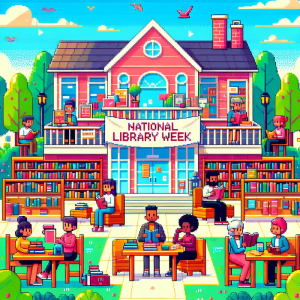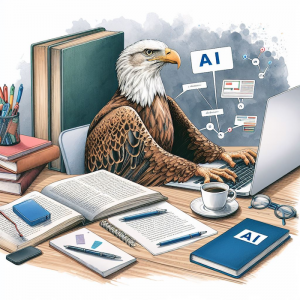GenAI@BC Libraries: GenAI & Citation
Have you started using generative AI and are now wondering when and how to credit the tool in your writing? You are in luck! Since next week is National Library Week, we thought that for this issue of our GenAI@Libraries series, we would focus on a topic dear to the hearts of academic librarians: citation.

When do I cite an AI?

When you use a tool like Microsoft Copilot, Gemini, ChatGPT, or other AI programs that can assist you with academic projects, you need to cite them following the same general principle that you use for other bibliographic references–to give them credit as the originator of the content. This means that you should cite the AI when you:
- Use it to generate ideas, process data, or generate code that you include in your work
- Quote or paraphrase the text it produces or use an image it creates
- Use it to edit your writing
- Use it to translate text
In other words, just as you are asked to reference human content creators, editors, or translators, you must cite an AI when it serves in the same capacity.
Be sure to check with your editor or professor about their AI policies before you begin using it. They may prohibit it, or they may specify other scenarios in which they want you to cite AI tools that go beyond the standard principles of citation.
When should I not cite an AI?
For many reasons recently enumerated in an article in the Columbia Journalism Review, it is best not to cite an AI as a source of scholarly content. AI chatbots are not search engines and do not have algorithms designed for information retrieval. As the CJR article indicates, they continue to produce incorrect citations, even when they have formal license arrangements providing them with access to published content. If you are interested in information given by an AI response, locate that same information in academic sources and cite them.
Many people often ask, “What about Grammarly? It’s AI–should I cite it, too?” Generally, the answer is no, unless you are a student and your professor has a different requirement (note that some professors prohibit the use of it entirely, especially if the goal of the course is for you to improve your writing and knowledge of grammar). Grammarly makes in-context corrections and suggestions for improvements as you type. It shapes the language you input and does not function as an editor, as generative AI tools do, which can rewrite and offer additions to improve the content. Again, if you are a student, check with your professor on their requirements; the general rule, though, is that for the same reasons you do not cite a spell-checker, you do not need to cite Grammarly.
How should I cite an AI?
Now that it has been over two years since ChatGPT was first introduced, style manuals are beginning to develop rules for citing AI that you can follow when formatting your references. Below are the latest guidelines provided by the major manuals used at BC:
- The APA (American Psychological Association) published directions for citing ChatGPT in the APA Style blog in 2023. If you are asked to use this style, you can adapt these directions to other generative AI tools. For transparency and clarity, it is good to follow the example that includes the full transcript of the prompt and response in an appendix.
- The MLA (Modern Language Association) also published instructions for citing generative AI in 2023, including examples.
- In its 18th edition, issued in September 2024, the Chicago Manual of Style added a section on citing AI-generated content (see 14.112). It emphasizes the importance of using a publicly available URL to the chat thread (see below) so that those reading your work can view the source you used.
Since AI technology is always changing, be on the lookout for updates to these manuals. Citation tips are also provided in the BC Libraries’ Generative AI guide.
How do I produce a publicly available URL for the AI-generated text to include in my citation?
At present, among Microsoft Copilot, Gemini, and ChatGPT, only ChatGPT exports a publicly available URL that can be used in a citation.1 Students needing to make a thread on Microsoft Copilot or Gemini available to their professor should copy the content into a separate document and place it in a cloud location (such as Google Drive) to which they can then share a link. They will have to set the permissions for that link to ones that will allow their professors to view the content. To learn more about sharing files on Google Drive, see the Google Help site. Those intending to submit their work for publication should check with the editors to determine the method they prefer for generating publicly available URLs.2
Here is an example of a citation in Chicago style for a text translated by ChatGPT, which features a publicly available URL:
¹Priscille Marschall, “Christ est-il appelé Dieu en Romains 9:5? L’argument des figures gorgianiques,” Novum Testamentum 64, no. 4 (2022): 468, https://doi.org/10.1163/15685365-bja10030. Translation generated by ChatGPT(GPT-4-turbo), OpenAI, March 17, 2025, https://chatgpt.com/share/67e58558-04ac-8001-8283-6aee4bbb73c3.
Is there anything else I should know about citing AI?

Yes! If you are permitted to use it in your work, staff in the BC Libraries are more than happy to help you with any questions you have in navigating through the process, including citation.
- When you are logged into ChatGPT, the “Share” button in the upper right corner of the screen will create a publicly available link. ↩︎
- Also note that manuals like the Chicago Manual of Style are encouraging authors to retain copies of non-published sources, and for web-based resources, they recommend using web-archiving services like the Save Page Now feature of the Internet Archive, or Harvard Innovation Lab’s Perma.cc (see Chicago, 13.17). ↩︎